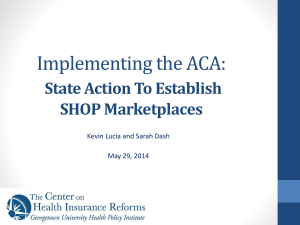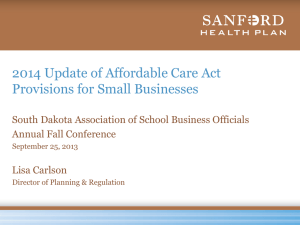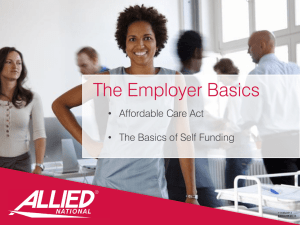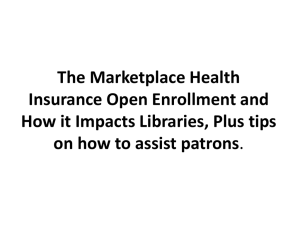Business Insurance - Affordable Care Act
advertisement
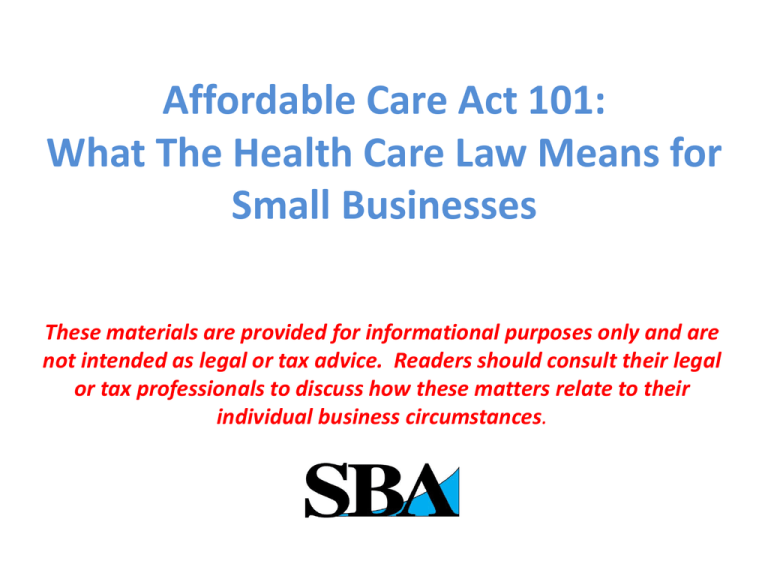
Affordable Care Act 101: What The Health Care Law Means for Small Businesses These materials are provided for informational purposes only and are not intended as legal or tax advice. Readers should consult their legal or tax professionals to discuss how these matters relate to their individual business circumstances. Small Business and Health Care For years, small businesses have reported that their NUMBER ONE concern has been access to AFFORDABLE HEALTH CARE. 2 ACA Reduces Premium Cost Growth and Increases Access to Affordable Care Before ACA, Small Employers Faced Many Obstacles to Covering Workers • Too few choices • Higher premiums and unpredictable rate increases • Higher rates for groups with women, older workers & those with chronic health concerns or high-cost illnesses, in most states • Waiting periods or no coverage for individuals with Pre-Existing Conditions May 7, 2014 Under the ACA, insurance companies: • Face limits on administrative spending. Most insurers must now spend at least 80 percent of consumers’ premium dollars on actual medical care • Must disclose and justify proposed rate hikes of 10% or more, which states, or the federal government, may review Can’t charge higher rates or deny coverage because of a chronic or pre-existing condition • • Can’t charge higher rates for women, and face limits on charging additional premiums for older employees • Must pool risks across small groups creating larger pools like large businesses • Must not have annual dollar limits on coverage • Must offer plans that provide a core package of “Essential Health Benefits” equal to typical employer plans in the state 3 ACA Reduces Premium Cost Growth and Increases Access to Affordable Care The Affordable Care Act increases access to affordable, quality health care for the self-employed and small businesses • For 2010 thru 2013, worth up to 35 percent of their premium contributions (25% for taxexempt employers) for their employees’ health insurance. For 2014 and beyond, eligible small businesses can get a tax credit worth up to 50 percent (35% for tax-exempts) for health coverage offered to employees through the SHOP. • Better options through new Health Insurance Marketplaces: Starting January 1, 2014, the self-employed and small businesses will have access to a range of affordable health care options no matter where they are located. 4 How Will ACA Impact Small Businesses? It often depends on the size of the business. How many employees does the 50 and business have? above 24 or fewer Number of Full-Time Equivalent (FTE) Employees Up to 50 5 Affordable Care Act Small Business Health Care Tax Credit 6 Businesses with 24 or Fewer FTE Employees 24 or fewer Number of FTE Employees 50 and above • If these smaller businesses provide coverage, they may qualify for the Small Business Health Care Tax Credit to help offset costs: – Must have average annual wages below $50,000; and – Contribute 50% or more toward employees’ self-only premium costs Up to 50 Note: The maximum tax credit is available to employers with 10 or fewer full-time equivalent employees and average annual wages of less than $25,000 7 Small Business Health Care Tax Credit • In 2010 - 2013, up to 35% of a for-profit employer’s premium contribution – Employers can still deduct remainder of contribution – Credit can be claimed through 2013 • Starting in 2014, the credit goes up to 50% – To take advantage of the credit, business must buy coverage through one of the new small business health insurance Marketplaces known as SHOP – Credit can be claimed for any 2 consecutive taxable years beginning in 2014 (or beginning in a later year) through the SHOP • Note that this is a Federal credit, and that some states may also have additional tax credits available 8 Businesses with Up to 50 FTE Employees 24 or fewer Number of FTE Employees 50 and above Up to 50 • Starting January 2014, if a small business of this size chooses to offer coverage, there is a new way to do so: Small Business Health Options Program (SHOP) Marketplace • Enhanced SB Health Care Tax Credits available for eligible employers participating in SHOP 9 Affordable Care Act January 1, 2014: Health Insurance Marketplaces 10 What is the SHOP Marketplace? SHOP = Small Business Health Options Program • Part of the Health Insurance Marketplace created by the Affordable Care Act (ACA) • Offers employers a choice of health insurance plans and dental plans and tools for making informed choices • Offers qualified small employers access to the enhanced Small Business Health Care Tax Credit—now worth up to 50% of employer’s premium contributions • Works with new insurance reforms to spur competition based on price and quality Note: If you have fewer than 50 full-time-equivalent employees, you’re not required to offer health insurance, and there’s no penalty if you choose not to. May 7, 2014 11 Who Can Purchase FF-SHOP Coverage? Small employers who: • Have 50 or fewer employees in 2014 • Have at least one common law employee • Offer coverage to all of their full-time employees o In the Federally-facilitated SHOP this means employees working on average 30 or more hours per week • Can be for-profit or tax-exempt • Meet minimum participation rates o In many states using Federally Facilitated SHOP Marketplace, at least 70% of full-time employees must accept your offer of insurance Visit the SHOP FTE Calculator HealthCare.gov/fte-calculator/ May 7, 2014 12 Options for the Self-Employed Use Health Insurance Marketplace for individuals, families • Sole proprietors and shareholders > 2% S corp. with no employees • Owners, co-owners and their spouses Important features of the individual Marketplace • Premium assistance may be available, depending on income • Individuals generally must enroll during Open Enrollment Period o Next Open Enrollment November 15, 2014 - February 15, 2015 • Special enrollment periods for those with “qualifying life events” and other limited circumstances o Including marriage, divorce, or having a baby May 7, 2014 13 Using the SHOP to Qualify for the Tax Credit in 2014 Find Out How Much the Tax Credit Might Be Worth to Your Business: The SHOP Tax Credit Estimator HealthCare.gov/small-businesstax-credit-calculator To Qualify for the Tax Credit in 2014 employers must: • Have employees enrolled in a SHOP Qualified Health Plan • Meet other requirements for the credit, and • Receive an “eligibility determination” from the SHOP Marketplace An eligibility determination from the Federally Facilitated SHOP • Means the SHOP Marketplace finds you meet the requirements to use the SHOP • Is not required before buying SHOP coverage • Is required to claim the Small Business Health Care Tax Credit o Must get determination before the end of 2014 o Should send application within a week of enrollment; no later than December 1 If you’re found not to be eligible after buying SHOP coverage • You can’t claim the tax credit, but • Your insurance company need not end your coverage May 7, 2014 14 Buying SHOP Coverage: When & How? When can you offer a SHOP Qualified Health Plan? • • Get started now, or offer anytime during the year Unlike Marketplace for individuals, no limited Open Enrollment period for the SHOP How do you buy a SHOP Qualified Health Plan? • For Federally Facilitated SHOP, in 2014 only—must use Direct Enrollment o o o • With Direct Enrollment you’ll: o o o o • Work directly with an agent, broker or insurance company Similar to how small businesses have gotten coverage in the past Use the same process for buying a SHOP Qualified Dental Plan Select a SHOP Qualified Health Plan to offer employees (and a SHOP Qualified Dental Plan, if applicable.) Submit a hard copy employer application to the FF-SHOP Have the agent, broker, or insurer help enroll those employees who accept Pay the insurance company, directly or with the help of an agent or broker In states running their own SHOP Marketplace o o May 7, 2014 Enrollment processes may differ Many offer online enrollment 15 Federally Facilitated SHOP Eligibility: How to Apply To apply to the Federally-facilitated SHOP Marketplace, you can: • • • • Ask an agent, broker or insurance company for help Get help from a Marketplace-approved Navigator or assister Get the paper application and instructions from HealthCare.gov Apply by phone through the SHOP Employer Call Center The SHOP Marketplace will notify you: • • • By phone and e-mail By regular mail, if you request this Within 3-5 days of receipt Role of the SHOP Marketplace : • • Determines whether you’re eligible to participate in the SHOP o This determination is a requirement for receiving the tax credit Does not determine whether you’re eligible to receive the tax credit. o This is an IRS matter May 7, 2014 16 Affordable Care Act 2015: Employer Shared Responsibility for Employee Health Insurance Coverage 17 Businesses with 50 or More FTE Employees 24 or fewer Employer Shared Responsibility Provisions Number of FTE Employees 50* and above Up to 50 *In 2015 there are two types of transition relief: (1) for businesses with 50 to 99 full-time equivalent employees; and (2) for businesses with 100 and above fulltime equivalent employees 18 Nearly All Small Firms Are Exempt from Employer Shared Responsibility • ACA exempts all firms that have fewer than 50 employees – nearly 96 percent of all firms in the United States or 5.8 million out of 6 million total firms – from any employer shared responsibility requirements. These 5.8 million firms employ nearly 34 million workers. • Many firms that do not currently offer coverage will be better able to do so because of lower costs and wider choices in the SHOP Marketplaces. 19 Employer Shared Responsibility Provisions: Key Definitions • Full-Time Employee: an employee who is employed on average 30 hours or more per week (or at least 130 hours of service in a given month). • Full-Time Equivalent (FTE) Employee: a combination of employees, each of whom individually is not a full-time employee because they are not employed at least 30 hours per week, but who, in combination, are counted as the equivalent of a full-time employee. – For example, two employees each of whom works 15 hours/week are added together to equal one full-time employee. • Controlled Group Employers: employers with common owners or who are otherwise related are aggregated together to determine whether they meet the threshold number of 50 or more FTE employees. 20 Employer Shared Responsibility Provisions If employer meets 50 (100 for 2015) full-time/FTE employee threshold, two scenarios for potential shared responsibility payment • EITHER (1) An employer does not offer coverage to at least 95%* of its full-time employees (and their dependents), OR (2) The coverage offered to employer’s full-time employees is not “affordable” or does not provide “minimum value” • AND At least one full-time employee receives a premium tax credit in the individual Marketplace *For 2015, replace 95% with 70% 21 Employer Shared Responsibility: Insurance Coverage Standards Coverage Provides Minimum Value Coverage is Affordable • Plan must cover, on average, at least 60% of the plan’s total cost of incurred benefits • HHS and IRS have an online calculator employers can use to input their plan details and determine if it meets the 60% value threshold. • Coverage is unaffordable if the full-time employee’s share of self-only coverage costs more than 9.5% of his/her annual household income • Affordability safe harbor: If the cost to the employee of a selfonly plan is not more than 9.5% of his/her wages as reported on Box 1 of the W-2, it’s deemed affordable for purposes of Employer Shared Responsibility 22 Summary of Employer Shared Responsibility Transition Relief in 2015 • 50 – 99 Full-time Equivalent Employees: Not subject to the ESRP rules • 100 or more Full-time Equivalent Employees: Must offer coverage to 70% (instead of 95%) of its full-time employees and their dependents to avoid the ESR payment • Certification Requirement: • Maintain FTEs throughout the year between 50 and 99 • Did not reduce # of employees or employees’ hours in order to qualify for the transition relief • Employer maintained previously offered health coverage to its employees 23 Employer Shared Responsibility Payments: Two Scenarios If Coverage Not Offered to At Least 95% (70% in 2015) of Full-Time Employees, Then If Coverage Offered to FullTime Employees, But Either Not Affordable or Does Not Meet Minimum Value, Then • Payment applies if any full-time employee receives a premium tax credit in the individual Marketplace • Payment owed: $2K/year times number of full-time employee (minus 30) (minus 80 in 2015) • Payment calculated separately for each month for which coverage not offered ($166.67/month) • Payment based on employer’s number of full-time employees for that month (minus the first 30) • Payment owed: $3K/year per fulltime employee who receives a premium tax credit in Marketplace • Payment calculated on monthly basis = $250/month • This payment can’t exceed payment described in Scenario # 1 (left hand column) 24 Advanced Premium Tax Credit Purchase Insurance on the Individual Marketplace Income between 100% and 400% of federal poverty level (Based on Modified Adjusted Gross Income: AGI + various non-taxable income) Not eligible for Government Sponsored Program SBA Washington Metropolitan Area District Office 25 Employer Shared Responsibility Provisions Other Key Points • No employer payment is owed for non-coverage of part-time employees even if they receive a premium tax credit in the Marketplace • If employer offers affordable coverage that provides minimum value to a full-time employee who declines it, no employer payment is owed for that employee • No payment is owed if an employee obtains coverage through means other than the individual Marketplace (e.g., spouse’s family coverage) • To avoid a payment, employers that offer coverage to full-time employees must also offer coverage to the dependents of those full-time employees who are children under age 26 (coverage need not be offered to spouses) 26 Small Business Resources www.Business.USA.gov www.sba.gov/healthcare www.healthcare.gov 27
